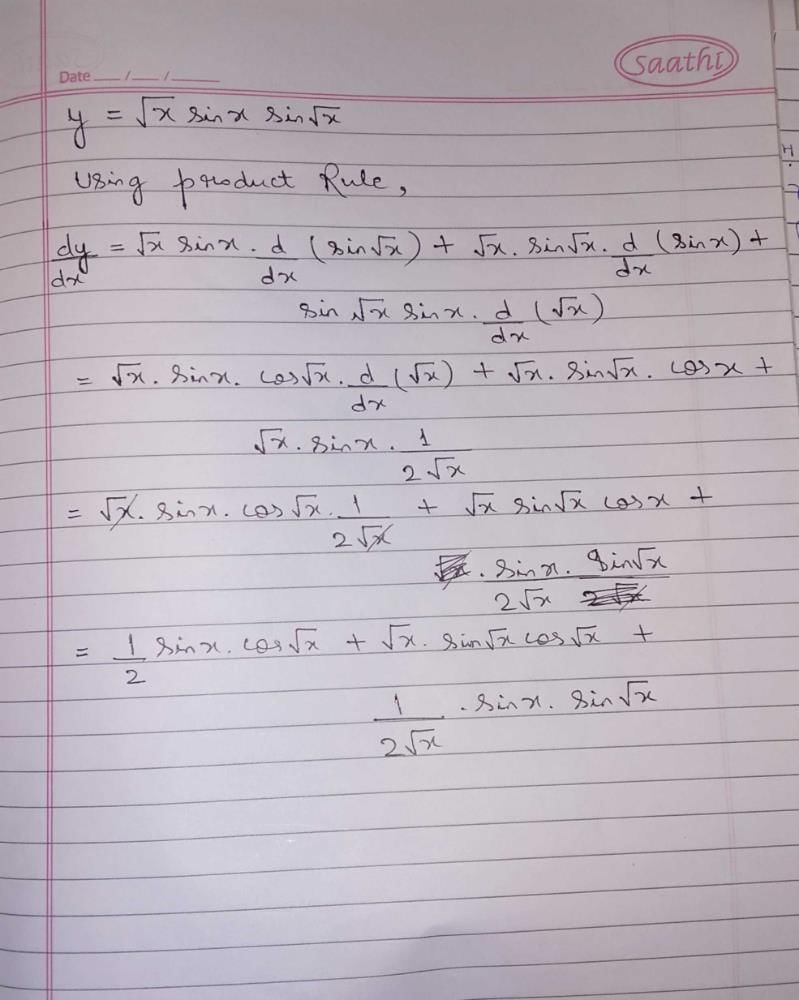Class 12 Exam > Class 12 Questions > √xsinx sin√x differentiation?
Start Learning for Free
√xsinx sin√x differentiation?
Most Upvoted Answer
√xsinx sin√x differentiation?

Community Answer
√xsinx sin√x differentiation?
**Differentiating √xsinx sin√x**
To differentiate the expression √xsinx sin√x, we can use the product rule of differentiation. The product rule states that if we have two functions u(x) and v(x), then the derivative of their product is given by:
(d/dx)(u(x)v(x)) = u'(x)v(x) + u(x)v'(x)
In this case, we can identify u(x) = √xsinx and v(x) = sin√x. Let's differentiate each of these functions separately and then apply the product rule to find the derivative of the expression.
**Differentiating √xsinx**
To differentiate √xsinx, we need to apply the chain rule since we have functions nested inside each other. The chain rule states that if we have a composite function f(g(x)), then the derivative of f(g(x)) is given by:
(d/dx)(f(g(x))) = f'(g(x)) * g'(x)
In this case, let's consider f(u) = √u and g(x) = sinx. The derivative of f(u) = √u is given by f'(u) = (1/2√u). The derivative of g(x) = sinx is g'(x) = cosx.
Now, we can apply the chain rule:
(d/dx)(√xsinx) = f'(g(x)) * g'(x)
= (1/2√u) * cosx
= (1/2√(sinx)) * cosx
So, the derivative of √xsinx is (1/2√(sinx)) * cosx.
**Differentiating sin√x**
To differentiate sin√x, we can use the chain rule again. Let's consider f(u) = sinu and g(x) = √x. The derivative of f(u) = sinu is f'(u) = cosu. The derivative of g(x) = √x is g'(x) = (1/2√x).
Now, we can apply the chain rule:
(d/dx)(sin√x) = f'(g(x)) * g'(x)
= cos(√x) * (1/2√x)
= (1/2√x) * cos(√x)
So, the derivative of sin√x is (1/2√x) * cos(√x).
**Applying the Product Rule**
Now that we have found the derivatives of √xsinx and sin√x, we can apply the product rule to find the derivative of √xsinx sin√x.
(d/dx)(√xsinx sin√x) = (√xsinx)' * sin√x + √xsinx * (sin√x)'
= [(1/2√(sinx)) * cosx] * sin√x + √xsinx * [(1/2√x) * cos(√x)]
Simplifying this expression further is not possible without additional information or constraints on x. So, the final derivative of √xsinx sin√x is [(1/2√(sin
To differentiate the expression √xsinx sin√x, we can use the product rule of differentiation. The product rule states that if we have two functions u(x) and v(x), then the derivative of their product is given by:
(d/dx)(u(x)v(x)) = u'(x)v(x) + u(x)v'(x)
In this case, we can identify u(x) = √xsinx and v(x) = sin√x. Let's differentiate each of these functions separately and then apply the product rule to find the derivative of the expression.
**Differentiating √xsinx**
To differentiate √xsinx, we need to apply the chain rule since we have functions nested inside each other. The chain rule states that if we have a composite function f(g(x)), then the derivative of f(g(x)) is given by:
(d/dx)(f(g(x))) = f'(g(x)) * g'(x)
In this case, let's consider f(u) = √u and g(x) = sinx. The derivative of f(u) = √u is given by f'(u) = (1/2√u). The derivative of g(x) = sinx is g'(x) = cosx.
Now, we can apply the chain rule:
(d/dx)(√xsinx) = f'(g(x)) * g'(x)
= (1/2√u) * cosx
= (1/2√(sinx)) * cosx
So, the derivative of √xsinx is (1/2√(sinx)) * cosx.
**Differentiating sin√x**
To differentiate sin√x, we can use the chain rule again. Let's consider f(u) = sinu and g(x) = √x. The derivative of f(u) = sinu is f'(u) = cosu. The derivative of g(x) = √x is g'(x) = (1/2√x).
Now, we can apply the chain rule:
(d/dx)(sin√x) = f'(g(x)) * g'(x)
= cos(√x) * (1/2√x)
= (1/2√x) * cos(√x)
So, the derivative of sin√x is (1/2√x) * cos(√x).
**Applying the Product Rule**
Now that we have found the derivatives of √xsinx and sin√x, we can apply the product rule to find the derivative of √xsinx sin√x.
(d/dx)(√xsinx sin√x) = (√xsinx)' * sin√x + √xsinx * (sin√x)'
= [(1/2√(sinx)) * cosx] * sin√x + √xsinx * [(1/2√x) * cos(√x)]
Simplifying this expression further is not possible without additional information or constraints on x. So, the final derivative of √xsinx sin√x is [(1/2√(sin

|
Explore Courses for Class 12 exam
|

|
Similar Class 12 Doubts
√xsinx sin√x differentiation?
Question Description
√xsinx sin√x differentiation? for Class 12 2024 is part of Class 12 preparation. The Question and answers have been prepared according to the Class 12 exam syllabus. Information about √xsinx sin√x differentiation? covers all topics & solutions for Class 12 2024 Exam. Find important definitions, questions, meanings, examples, exercises and tests below for √xsinx sin√x differentiation?.
√xsinx sin√x differentiation? for Class 12 2024 is part of Class 12 preparation. The Question and answers have been prepared according to the Class 12 exam syllabus. Information about √xsinx sin√x differentiation? covers all topics & solutions for Class 12 2024 Exam. Find important definitions, questions, meanings, examples, exercises and tests below for √xsinx sin√x differentiation?.
Solutions for √xsinx sin√x differentiation? in English & in Hindi are available as part of our courses for Class 12.
Download more important topics, notes, lectures and mock test series for Class 12 Exam by signing up for free.
Here you can find the meaning of √xsinx sin√x differentiation? defined & explained in the simplest way possible. Besides giving the explanation of
√xsinx sin√x differentiation?, a detailed solution for √xsinx sin√x differentiation? has been provided alongside types of √xsinx sin√x differentiation? theory, EduRev gives you an
ample number of questions to practice √xsinx sin√x differentiation? tests, examples and also practice Class 12 tests.

|
Explore Courses for Class 12 exam
|

|
Signup for Free!
Signup to see your scores go up within 7 days! Learn & Practice with 1000+ FREE Notes, Videos & Tests.



















